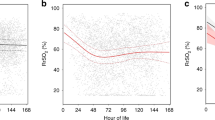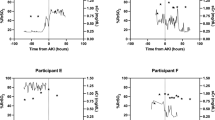Abstract
Background
In pre-term infants, the postnatal changes in the regional oxygen saturation (rSO2) of the brain and kidney are unclear.
Methods
We performed a prospective observational study. We measured the cerebral/renal rSO2 ratio and recorded the associated clinical features of infants born at 23 to 41 weeks of gestation weekly from the early postnatal period to discharge.
Results
The median cerebral/renal rSO2 ratios (interquartile ranges) between birth and the expected date of birth were 1.13 (1.06–1.26) at 23–24 weeks (n = 7), 1.18 (1.10–1.32) at 25–26 weeks (n = 11), 1.24 (1.11–1.37) at 27–28 weeks (n = 9), 1.12 (1.05–1.19) at 29–30 weeks (n = 4), 1.11 (1.03–1.15) at 31–32 weeks (n = 5), 1.02 (0.98–1.06) at 33–34 weeks (n = 9), 0.98 (0.94–1.06) at 35–36 weeks (n = 19), and 0.95 (0.86–0.99) at 37–41 weeks of gestation (n = 22). The median cerebral/renal rSO2 ratio did not significantly change after birth, but with increasing gestational age, the cerebral/renal rSO2 ratio at the expected date of birth decreased (r = − 0.74, p < 0.001). Nephrotoxic drugs did not affect cerebral/renal rSO2 at the expected date of birth, after adjustment for clinical factors.
Conclusions
Unlike in most infants born after the late pre-term period, the renal rSO2 remained lower than the cerebral rSO2 on the expected date of birth in infants born very pre-term.


Similar content being viewed by others
Abbreviations
- rSO2 :
-
Regional oxygen saturation
- CKD:
-
chronic kidney disease
- PDA:
-
patent ductus arteriosus
- SpO2 :
-
pulse oximetric saturation
- IQR:
-
interquartile range
References
Bernal NP, Hoffman GM, Ghanayem NS, Arca MJ. Cerebral and somatic near-infrared spectroscopy in normal newborns. J Pediatr Surg. 2010;45:1306–10.
Montaldo P, De Lenonibus C, Giordano L, De Vivo M, Giliberti P. Cerebral, renal and mesenteric regional oxygen saturation of term infants during transition. J Pediatr Surg. 2015;50:1273–7.
Blohm ME, Obrecht D, Hartwich J, Singer D. Effect of cerebral circulatory arrest on cerebral near-infrared spectroscopy in pediatric patients. Pediatr Anesth. 2014;24:393–9.
Danduran MJ, Dixon JE, Rao RP. Near infrared spectroscopy describes physiologic payback associated with excess postexercise oxygen consumption in healthy controls and children with complex congenital heart disease. Pediatr Cardiol. 2012;33:95–102.
Bauer A, et al. Evaluation of Hemodynamic and Regional Tissue Perfusion Effects of Minimized Extracorporeal Circulation. J Extracorpor Technol. 2010;42:30–9.
van der Laan ME, et al. A hemodynamically significant patent ductus arteriosus does not affect cerebral or renal tissue oxygenation in preterm infants. Neonatology. 2016;110:141–7.
Chock VY, Rose LA, Mante JV. Near-infrared spectroscopy for detection of a significant patent ductus arteriosus. Pediatr Res. 2016;80:675–80.
Mintzer JP, Parvez B, Alpan G, LaGamma EF. Effects of sodium bicarbonate correction of metabolic acidosis on regional tissue oxygenation in very low birth weight neonates. J Perinatol. 2015;35:601–6.
McNeill S, Gatenby JC, McElroy S, Engelhardt B. Normal cerebral, renal and abdominal regional oxygen saturations using near-infrared spectroscopy in preterm infants. J Perinatol. 2011;31:51–7.
Crump C, Sundquist J, Winkleby MA, Sundquist K. (2019) Preterm birth and risk of chronic kidney disease from childhood into mid-adulthood: national cohort study. bmj 365. https://doi.org/10.1136/bmj.1346.
Carmody JB, Charlton JR. Short-term gestation, long-term risk: prematurity and chronic kidney disease. Pediatrics. 2013;131:1168–79.
Brenner BM, Diego LG, Sharon A. (1988) Glomeruli and blood pressure: less of one, more the other?. American journal of hypertension 1.4_Pt_1; 335–347.
Sellmer A, et al. Urinary neutrophil gelatinase-associated lipocalin in the evaluation of patent ductus arteriosus and AKI in very preterm neonates: a cohort study. BMC Pediatr. 2017;17:7.
Lin YJ, Chen CM, Rehan VK, Florens A, Wu SY, Kuo YT, et al. Randomized trial to compare renal function and ductal response between indomethacin and ibuprofen treatment in extremely low birth weight infants. Neonatology. 2017;111:195–202.
Liu P, Capitano B, Stein A, El-Solh AA. (2017) Clinical outcomes of linezolid and vancomycin in patients with nosocomial pneumonia caused by methicillin-resistant Staphylococcus aureus stratified by baseline renal function: a retrospective, cohort analysis. BMC nephrology 18.1;1–10.
Haycock GB. Management of acute and chronic renal failure in the newborn. Seminars in neonatology Vol. 2003;8(4):325–34. https://doi.org/10.1016/S1084-2756(03)00044-7.
Selewski DT, et al. Neonatal acute kidney injury. Pediatrics. 2015;136:463–73.
Vidal E, Amigoni A, Brugnolaro V, Ghirardo G, Gamba P, Pettenazzo A, et al. Near-infrared spectroscopy as continuous real-time monitoring for kidney graft perfusion. Pediatr Nephrol. 2014;29:909–14.
Choi DK, Kim WJ, Chin JH, Lee EH, Hahm KD, Sim JY, et al. Intraoperative renal regional oxygen desaturation can be a predictor for acute kidney injury after cardiac surgery. J Cardiothorac Vasc Anesth. 2014;28:564–71.
Eknoyan G, Lameire N, Eckardt K, Kasiske B, Wheeler D, Levin A, et al. KDIGO 2012 clinical practice guideline for the evaluation and management of chronic kidney disease. Kidney Int. 2013;1:5–14.
Toyoshima K, et al. Tailor-made circulatory management based on the stress–velocity relationship in preterm infants. J Formos Med Assoc. 2013;112:510–7.
Schwartz GJ, Haycock GB, Edelmann CM Jr, Spitzer A. A Simple Estimate of Glomerular Filtration Rate in Children Derived From Body Length and Plasma Creatinine. Pediatrics. 1976;58:259–63.
Levey AS, Coresh J, Bolton K, Culleton B, Harvey KS, Ikizler TA, et al. K/DOQI clinical practice guidelines for chronic kidney disease: evaluation, classification, and stratification. Am J Kidney Dis. 2002;39:1–266.
Beck J, et al. Monitoring cerebral and renal oxygenation status during neonatal digestive surgeries using near infrared spectroscopy. Front Pead. 2017;5:140. https://doi.org/10.3389/fped.2017.00140.
Schlader ZJ, Rivas E, Soller BR, Convertino VA, Crandall CG. Tissue oxygen saturation during hyperthermic progressive central hypovolemia. Am J Physiology-Regulatory Integr Comp Physiol. 2014;307:731–6.
Choi DK, et al. Intraoperative renal regional oxygen desaturation can be a predictor for acute kidney injury after cardiac surgery. J Cardiothorac Vasc Anesth. 2014;28:564–71.
Algra SO, Schouten AN, van Oeveren W, van der Tweel I, Schoof PH, Jansen NJG, et al. Low-flow antegrade cerebral perfusion attenuates early renal and intestinal injury during neonatal aortic arch reconstruction. J Thorac Cardiovasc Surg. 2012;144:1323–8.
Mintzer JP, Moore JE. Regional tissue oxygenation monitoring in the neonatal intensive care unit: evidence for clinical strategies and future directions. Pediatr Res. 2019;863:296–304.
van Bel F, Mintzer JP. Monitoring cerebral oxygenation of the immature brain: a neuroprotective strategy? Pediatr Res. 2018;842:159–64.
Kooi EMW, et al. Measuring cerebrovascular autoregulation in preterm infants using near-infrared spectroscopy: an overview of the literature. Expert Rev Neurother. 2017;17:801–18.
Vieux R, Hascoet JM, Merdariu D, Fresson J, Guillemin F. Glomerular filtration rate reference values in very preterm infants. Pediatrics. 2010;125:1186–92.
Rodríguez MM, Gómez AH, Abitbol CL, Chandar JJ, Duara S, Zilleruelo GE. Histomorphometric Analysis of Postnatal Glomerulogenesis in Extremely Preterm Infants. Pediatr Dev Pathol. 2004;7:17–25.
Sutherland MR, Gubhaju L, Moore L, Kent AL, Dahlstrom JE, Horne RS, et al. Accelerated maturation and abnormal morphology in the preterm neonatal kidney. J Am Soc Nephrol. 2011;22:1365–74.
Hernandez-Meza G, Izzetoglu M, Osbakken M, Green M, Izzetoglu K. Near-infrared spectroscopy for the evaluation of anesthetic depth. Biomed Res Int. volume 2015. Article ID 939418 https://doi.org/10.1155/2015/939418.
Fanos V, Cataldi L. Renal transport of antibiotics and nephrotoxicity: a review. J Chemother. 2001;13:461–72.
Perazella MA. Drug-induced renal failure: update on new medications and unique mechanisms of nephrotoxicity. Am J Med Sci. 2003;325:349–62.
Bonsante F, et al. Low renal oxygen saturation at near-infrared spectroscopy on the first day of life is associated with developing acute kidney injury in very preterm infants. Neonatology. 2019;115:198–204.
Acknowledgements
We thank Mark Cleasby, PhD from Edanz (https://jp.edanz.com/ac) for editing a draft of this manuscript.
Author information
Authors and Affiliations
Contributions
Daisuke Yoshida: Conceptualization, Original draft preparation. Tomoyuki Shimokaze: Writing- Reviewing and Editing. Tomoko Saito: Data curation, Investigation. Katsuaki Toyoshima, Atsushi Kondo: Supervision.
Statement of financial support
There was no relevant funding for this study.
Disclosure statement
The authors declare no conflicts of interest.
Corresponding author
Ethics declarations
Statement of financial support
There was no relevant funding for this study.
Consent Statement
Written consent to participate in the study was obtained from the parents of the infants whose rSO2 was measured in the maternity ward for the study. We routinely measured rSO2 for clinical management purposes in infants admitted to the Neonatal Intensive Care Unit (NICU). Infants admitted to the NICU were not required to give informed consent for their participation in the study because the analysis used anonymized clinical data that were obtained after the guardian of each patient agreed to treatment by providing their written consent. We also adopted an opt-out system and posted a summary of the study on the hospital’s website (http://kcmc.kanagawa-pho.jp/about/ethics_research.html).
Ethics approval
The study was conducted in accordance with the principles contained within the Declaration of Helsinki and approved by the institutional review board of Kanagawa Children’s Medical Center (No. 1807-7, 2019).
Consent to participate
All the authors were responsible for diagnosis and the treatment of the patients. All the authors have read and approved the final version of the manuscript.
Consent for publication
All the authors are aware of the submission and agree that, if accepted, the manuscript and artwork will become the property of the publisher.
Additional information
Publisher’s Note
Springer Nature remains neutral with regard to jurisdictional claims in published maps and institutional affiliations.
Rights and permissions
About this article
Cite this article
Yoshida, D., Shimokaze, T., Kondo, A. et al. Changes in regional oxygen saturation of the kidney and brain of infants during hospitalization. J Clin Monit Comput 36, 1859–1867 (2022). https://doi.org/10.1007/s10877-022-00836-y
Received:
Accepted:
Published:
Issue Date:
DOI: https://doi.org/10.1007/s10877-022-00836-y




